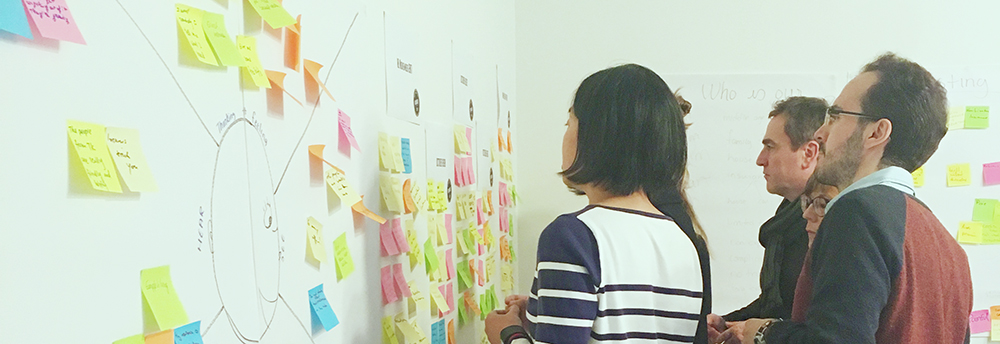How Can the Insurance Industry Contribute to Suicide Prevention?
In Britain, 17 people die of suicide daily on average, and men are three times more likely to take their own lives as women. Suicides have tremendous impact on humans emotionally and trigger financial costs, so RGAX decided to run a three-day design thinking sprint in London to understand how the insurance industry could contribute potential solutions for suicide prevention in the region.
Suicide: a societal and insurance industry challenge
When a claims manager from RGA in the UK raised the issue of how our industry could help prevent suicides, we began exploring the problem and learned of a number of people in the insurance industry who volunteer with non-profit organizations that focus on suicide prevention.
One of these is Samaritans, a UK non-profit. We learned of a Samaritans marketing campaign that displayed posters on a rail line, promoting their suicide hotline. The result? Suicides on the rail lines decreased by 20 per cent. This low-cost initiative clearly helped save many lives, as well as helping the rail industry serve their users better.
Considering how suicide affects our industry, healthcare and society in general (we estimate the UK life insurance industry paid out more than £100m on suicide claims in 2017), we were eager to contribute. Running a sprint that combined industry collaboration with Cookhouse Pop-Up Lab design thinking methodologies would give us the opportunity to learn more and work with people directly impacted by this crisis in the region. 
Using our network to bring people together to solve problems
Despite the sensitive nature of this topic, we found that people were eager to get involved to find solutions for suicide prevention. All of the participants had both a personal and professional (i.e. challenge in their organization) connection to this societal issue, and they came together to solve it.
Usually when running a design thinking sprint, we aim for a group size of six to eight participants. In this case, we had such a strong interest from candidates that we chose nine: a diverse group of reinsurers, insurers and consultants, many with operational experience in actuary, claims, or underwriting.
Participants of this design thinking sprint were from the following organizations:
- Agrippa
- Aviva
- EY
- Legal & General
- Munich Re
- Pacific Life Re
- Reinsurance Group of America
- SCOR
- Vitality
Two experts in the suicide prevention field also joined a session on the first day as masterminds, generously sharing their knowledge and experience to help the project team complete empathy and customer journey maps. In addition, the participants grabbed inspiration from 17 lightning demos about male suicide prevention tactics used by others. With much motivation and purpose, the team cooked up a diverse set of ideas and solutions.
In just three days this fast-moving project team created three solutions to save lives – a tremendous feat! Each solution targets suicide prevention at a different level: specific, macro and strategic. Let’s take a look at what they cooked up:
Specific: This solution was formed to address the fact that a suicide of a relative can be a trigger event for other suicides. The project team came up with the idea for insurers to send a handwritten condolence note including information on how to seek help and self-care to a suicide-related claimant. This small but personal touch humanizes a currently formal touch point and could help reduce the claim suicide as a trigger event for another suicide among family or friends.
Macro: The next solution was a macro-level campaign to promote mental health awareness and human interaction in London communities. The project team envisioned this happening by placing thirty six-foot penguins around London, which would encourage people to stop, think and interact.
Penguins were chosen because they are known to huddle together to keep each other warm, and move from the inside to the outside of the group to make sure no one is left behind. The group felt it was representative of a community coming together to address suicide prevention and learn how to help the cause. Plus, they felt large penguins would get the attention of people! Each penguin would also have a digital interactive element so pedestrians could learn more.
Strategic: The strategic level solution involved forming an industry working group to catalyze actions within the insurance industry targeted at contributing to suicide prevention activities. The group would span operational teams (e.g. underwriting, claims) to address suicide from all perspectives in insurance.
Solving an industry problem in one locale can have a global impact
The problem of suicide is not limited to the UK. By devoting our attention and resources to thinking deeply about a problem, it shines a light on root causes and issues that people may have ignored or overlooked. One of the biggest takeaways from this design thinking sprint was: don’t be afraid to tackle a sensitive subject. We all benefit when a workable solution is created, because it may spark an idea that can help solve a problem somewhere else. By looking at our industry’s processes through the lens of suicide, we identified many simple steps that could be taken to improve things.
Similarly, there are other common challenges and problems that exist across the insurance industry and global communities. Doing a deep dive on of these challenges in a specific region can trigger a positive change globally.
Want to get involved with suicide prevention?
Thank you to all of the participants for bringing their innovative minds and compassion together for this project. If your organization is interested in joining this group of innovators for the next steps for this project, or if you have an idea for another social challenge in need of an insurance industry solution, please contact Mitch Ocampo at mitch.ocampo@rgax.com.
Thanks to Jonathan Hughes for sharing insights from facilitating the design thinking sprint to contribute to this blog.

